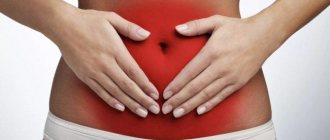The abdomen in young children usually protrudes and is balanced by a strong forward curve of the lower spine. By the third year of life, the child's stomach looks flatter, the back is straighter, and the legs become relatively longer. If you are not sure that your child has correct posture, contact your pediatrician .
THE DOCTOR'S CONSULTATION
Call your pediatrician if:
- the abdomen is enlarged, hard, or painful
- your child has diarrhea, vomiting, or severe constipation
- temperature above 38°C
ATTENTION!
An enlarged abdomen sometimes indicates a disease of the digestive system or other organs. Causes may include fluid, gas, or intestinal obstruction.
| ASK YOURSELF A QUESTION | POSSIBLE REASON | WHAT TO DO |
| Does your child have stool retention, but there are no signs of discomfort? | Constipation | Increase the amount of vegetables, fruits (except bananas) and liquids in your child's diet. If you still don't have bowel movements, contact your pediatrician (see Constipation) |
| Did abdominal enlargement and pain appear suddenly? Accompanied by repeated vomiting? Is your general condition getting worse? Does passing gas relieve the pain a little? | Intestinal obstruction | Call emergency services immediately (see also Acute abdominal pain) |
| Is the stool large in volume, discolored, or foul-smelling? Is there a lot of gas coming out? Does your child have a constant cough and is not gaining weight well? | Poor digestion, e.g. celiac disease, cystic fibrosis | Make an appointment with a pediatrician who will examine your child and prescribe tests. Depending on the diagnosis, one or another treatment will be recommended. |
| Has your child recently had a streptococcal infection, such as a sore throat or impetigo? Is the urine dark or red-brown? Are there swellings under the eyes and on the face? Headache and/or fever? | Glomerulonephritis (kidney inflammation) after streptococcal infection | Call "emergency" . Without urgent treatment, the disease can lead to acute renal failure |
| In addition to an enlarged abdomen, is there swelling of the entire body, especially pronounced under the eyes and on the face? Urine looks normal but scanty? | Neurotic syndrome | Call your child's doctor immediately . This kidney disease (most often found in boys 1-6 years old) without timely treatment can lead to chronic renal failure! |
| Is the enlargement most pronounced in the upper abdomen? The child also has a fever; Do bruises appear on the skin for no apparent reason? Is your child losing weight? | Possible blood disease | Contact your pediatrician |
FOR INFORMATION
Swelling around the navel
If your belly button seems to stick out more when you cry, your baby may have an umbilical hernia. In this case, with increased intra-abdominal pressure, the abdominal organs can bulge out through the muscles of the anterior abdominal wall. This disease is not severe and often goes away without treatment by the 3-4th year of life. If this does not happen, surgery may be required.
Why is this happening?
The baby's body continues to develop after birth. The newborn’s nutrition must now be restructured; this is not easy. By about 6 months, the intestines will be developed enough to digest food without problems and cope with bowel movements and intestinal gases. And now you will have to be patient, using special measures to help the baby.
Everything was different in my mother’s tummy; after giving birth, all systems of the small body must learn to work in a new way. It is difficult for the intestines to push processed food through. Even small lumps can get stuck, blocking the passage of intestinal gases. In a one-month-old baby, everything is so tiny that even a small bubble of gas will put a lot of pressure on the wall of the intestine, and the baby will be in pain.
Symptoms
Most of the time, children feel good, the tummy tenses and becomes hard after feeding, if this is related to nutrition. We must be attentive to the mood and behavior of children. If you are worried, unwaddle the baby, examine his posture, monitor his behavior, and evaluate his symptoms.
The most common causes of a hard abdomen in infants are intestinal colic and bloating.
Symptoms of colic:
- the baby is capricious;
- blushes;
- pushing;
- pulls the legs towards the tummy;
- the area around the navel tenses and becomes hard.
Colic begins 15 - 20 minutes after feeding, lasts about half an hour, and resumes at the next feeding. In the evening, such spasms usually intensify.
The baby may kick his legs. This means he will raise and lower them alternately, pulling them towards his stomach. At the same time, he may express dissatisfaction and concern by crying and groaning. This is how bloating in a child manifests itself.
Preventive measures against flatulence
One of the most famous doctors involved in the fight against bloating in newborns is Komarovsky. He devoted quite a lot of time to studying this problem and found that flatulence can be prevented if one begins to prevent this problem long before its manifestation.
Research shows that by adhering to the following recommendations, you can reduce the likelihood of bloating and colic in infants by approximately 20%:
- Feeding with breast milk, not artificial formula.
- Mother's refusal to eat unhealthy foods. Doctors advise excluding fried and fatty foods, smoked foods and marinades, as well as foods that are difficult for the stomach, from your daily diet. It is worth eating more fresh fruits, steamed or boiled vegetables, and porridge.
- After each meal, the child should be allowed to lie on his tummy for a while.
When flatulence occurs in older children, it is recommended to spend as much time as possible in the fresh air, play outdoor games, and also adhere to a healthy diet. In addition, it is very important to protect the child from all kinds of stressful situations by providing comfortable conditions for staying at home.
See a doctor immediately
Intestinal colic and bloating are normal processes during digestion. They cause discomfort, but will pass over time. Their course can be eased. But there are situations that are associated with painful changes in the child’s body. You need to know the signs in order to consult a doctor in a timely manner. You can’t try to treat something like this in a little person on your own at home.
Dangerous symptoms:
- crying when the stomach is touched;
- crying for more than an hour due to diarrhea or constipation;
- temperature 38o or more;
- there are streaks of blood in the stool;
- vomit is yellow-green in color.
You need to call an ambulance, and before it arrives, do not give your child any medications, so as not to change the symptoms.
Obesity in children. Age stages of development. 1 year – 7 years
Murzaeva Irina Yurievna
Endocrinologist, Preventive Medicine Doctor
February 8, 2015
Let's continue the conversation about childhood obesity... The age interval from 1 year to 7 years is the period when the foundations of proper nutrition are laid, the period of transition from individual feeding to a common table. Especially if the child is underweight, during this age period there is a high risk of “out of great love” feeding (more correctly, overfeeding) the child and laying the foundations for future obesity in him. And there is no need to even doubt that a child can be overfed.
At this age interval, it becomes especially clear what genetic morphotype the child resembles. That is, which of the relatives the child repeats in body structure - mother, father, grandfather, cousin, etc. In this regard, we can roughly assume the pace and nature of further weight gain (on the hips, abdomen, shoulder girdle, etc.).
There are also psychological aspects in the formation of eating habits during this age period. Appetite and food traditions or the usual composition of the diet at this age can only be established by adults, since the child’s cerebral cortex is not yet sufficiently developed, and therefore there are no concepts of “willpower” and “self-restraint”. The child will be drawn to what is tasty and what you have accustomed him to, for example, candy.
It is especially easy to cause shifts in a child’s metabolic processes during a period of intensive growth. The entire period of child growth can be divided into 5 periods:
- 1-4 years – called the “first phase of weight gain.” It differs in that after 1 year of life, the digestibility of carbohydrates by the child’s body decreases significantly; carbohydrates are easily stored in fat, especially if there is an excess of them.
- The period of the first “stretching” occurs at the age of 5-8 years. During this period, it is more important for the body to receive proteins rather than carbohydrates, as a “building material for growth.” Excess carbohydrates actually slow down growth processes!!!
- After this, the “3rd phase of weight gain” or rounding begins, this is the age of 8-10 years, which also should not be enhanced by high-carbohydrate foods (sweets and baked goods).
- The 4th extension phase occurs at 11-15 years of age, this is the second growth spurt. The need for protein products is increasing again.
- period – “phase 3 of weight gain” (age 15-20 years), no longer needs comments.
Between the ages of 1 and 7 years, a child rarely gains weight quickly, more often gradually, which is not very noticeable to parents who see him every day. But this is not a reason not to calculate your diet in the future.
Now about the terms for this age period.
The degree of obesity in children is assessed by body weight relative to height according to centile tables in absolute numbers (kg) and as a percentage of excess (%). 15-25% excess is 1 degree of obesity. 26-50% – 2nd degree, 51-100% – 3rd degree, more than 101% – 4th degree. In addition, the abdominal circumference is assessed - for girls and boys separately by age (there is a corresponding table). The body mass index (BMI) is assessed (as in adults), only children have their own standards.
The data is entered into tables of the dynamics of body weight (kg) and BMI, from which it is easy to trace age characteristics and critical periods of weight gain on an individual basis.
Below are some BMI graphs. Less commonly, the thickness of the skin-fat folds of the body is assessed and the percentage of body fat is calculated based on gender and age. I don’t present these calculations here; you do the calculations at your appointment with your doctor. I would not determine the type of obesity/and body type during this age period (alimentary, central or other obesity, genoid, android type), this will be visible in the next period of life in the stage of prepuberty and puberty.
Just at this age, some hormonal parameters, determined genetically, can affect weight gain. Therefore, there is a need to donate blood for indicators of thyroid function (TSH, free T4), carbohydrate metabolism (blood sugar, insulin (I would not recommend constructing a sugar curve with a glucose load of 1.75 g per 1 kg of weight in this age period!), metabolism fats (cholesterol/triglycerides are elevated in children!).
It is important to remember that a healthy child’s body is equipped with an amazing innate mechanism that determines how much and what kind of food it needs to eat for normal growth and development (if we are not talking about chronic diseases, neuroses and other deviations). There is no need to force a child to eat, you need to create conditions so that he wants to eat himself. The main thing in this process is: diet and regularity! The stomach volume of a child of this age is 250 ml, so there is no need to try to put more food there at one meal. In addition, often during this period the body’s enzyme system may be “immature” and cannot cope with a large volume of food at one time; as a result, food is absorbed poorly broken down and is deposited rather than used for energy production/as a building material for cells, aka remains not fully processed, so it is used as a reserve.
And if we take into account that the child may have digestive problems - gallbladder dyskinesia, has recently suffered from intestinal dysbiosis or rotavirus diarrhea, or has partial lactase deficiency, then there can be no talk of complete breakdown of food without auxiliary means.
If a child was born from a mother who had gestational diabetes, then fat metabolism disorders are usually more common in such children, which makes nutritional monitoring necessary. If both parents of a child are obese, the risk of obesity increases to 80%.
Once again, summing up what was written above, what can provoke obesity in this age period:
- birth trauma, asphyxia, gestational diabetes, gestosis in the second half of pregnancy,
- binge eating
- shift in appetite for the 2nd half of the day
- protracted and frequent acute respiratory infections
- concomitant diseases of the gastrointestinal tract
- much less often - hormonal imbalance
There are many more factors leading to childhood obesity during this period, but I think it is more important to focus on diet, and not on theory, I think there is already enough of it
About diet...
So, this diet is called SC (subcalorie), there are only 3 of them: SC1, SC2, SC3. They are calculated according to the degree of obesity (1-2, 3, 4) each has its own duration, composition and calorie content. It makes sense to keep a food scale at home.
The SC regime is preceded by a period of adaptation (1) its task is to move a larger volume of food to the first half of the day, establish split 5-6 meals a day, have dinner no later than 19.00-19.30. This transition does not occur in one day, this period can last 1- 3 months for grade 1 obesity, 2-3 months for grade 2-3, and so on. And only then comes the stage of the SC regime (2).
Example of SC mode -1 (age 1-3 years):
Breakfast - porridge (except semolina) 100 g, bread 10 g, drained butter 5 g, egg 1 piece 2 Breakfast - apple 50 g Lunch - vegetable soup 100 g, rice porridge 30 g, milk for porridge 50 g, butter 5 g, fish cutlet 60 g , rye bread 25g, tomato 25g dried fruit compote; Afternoon snack - applesauce 100g, cottage cheese 50g, Dinner - vinaigrette 200g + meat 10g Second dinner - kefir 200g, bread 25g.
#
Example of SC mode -2 (age 4-7 years): Breakfast - porridge 150 g, milk for porridge - 150 g, sugar - 10 g, cheese - 5 g, butter 5 g 2 breakfast - apples 100 g Lunch - rye bread - 40 g, vegetable soup with meat broth – 150 g + vegetables in it – 170 g, potatoes. puree 150 g, drained butter - 5 g, meat cutlet - 100 g; cucumber - 50g, dried fruit compote - 1 glass Afternoon snack - kefir - 200g Dinner - omelet - 1 egg + 50g milk, rye bread 20g Dinner apple - 50g.
You can have any fruit except grapes, banana – not every day. Sweets, baked goods – rarely, marshmallows without chocolate are preferable due to the content of apple pectin in it, which improves bile secretion. Seeds and nuts are not allowed - they are difficult to digest at this age. And no mayonnaise, ketchup, hot sauces, coffee or other appetite stimulants. It’s inconvenient to even write about soda, chips, and French fries.
The fat content of foods at this age is not limited; all restrictions are mainly due to “light” carbohydrates. My sincere advice to loving grandparents: “don’t deserve the child’s attention in such a primitive way” - no sweets, waffles, caramel! If you want to feed your child properly and tasty, there is now enough literature and cooking programs.
Calorie content, of course, is calculated individually, so which option CK1, CK2 or CK3 is considered in each specific case. Calorie intake is calculated using the formula:
Weight 11-20 kg = 1000 kcal + 10 kcal (actual body weight -10)
Weight over 20 kg = 1500 kcal + 20 kcal (actual body weight -20)
If the child continues to receive breast milk/or formula, then it is necessary to focus on the amount of food: (carrying out a control weighing of the child after meals). Compliance with the SC regimen must occur under the supervision of a physician.
Weight loss medications at this age are prescribed extremely rarely, by a council of doctors, for grade 4 obesity.
To be continued... we will talk about gender differences in weight gain, types of obesity and approved weight loss drugs.
These are BMI (body mass index) tables = weight (kg) / height (m2) divided by meter squared.
From the tables, it’s not difficult to guess when excess weight begins - above the indicators - normal, and obesity - in the indicators column - overweight
For example, a 4-year-old girl, 100 cm (1 m) tall and weighing 22 kg, has a BMI of 22, which is clearly obese according to the table.
How can I help my child?
If you have established for sure that this is not a disease, but a hard tummy is a symptom of food digestion, you can help the crying baby using your own methods.
- We must try to calm the baby down. Nervousness further intensifies muscle spasms. But for this the mother must be calm. Children, especially infants, are very sensitive to their mother's mood. You should talk affectionately to the baby, stroke him, and hold him close.
- A light tummy massage helps. You need to stroke it clockwise to make it easier for gases to descend through the intestines. You can start around the navel, then increase the diameter and go over the entire surface of the tummy.
- A warm diaper, heated with a hot iron, will relax the muscles of the tummy, restore patency, and intestinal gases will easily go away. The diaper is placed on the baby's tummy.
- It is easier for a baby to poop lying on his side or stomach. If the baby cries, strains, probably wants to poop, change his position - put him on his side, press his knees to his tummy, he will feel better.
- Experts recommend placing the baby on its tummy on a hard surface before feeding. A few minutes will be enough to ease the passage of gas.
- You can do special exercises - bring the child’s bent knees to the stomach and hold for several seconds. Alternate left and right legs, then both legs together. It is advisable to do exercises regularly, but only when the baby is in a good mood.
- Dill water copes well with intestinal gases. Before using it, you should consult your pediatrician. 2 large spoons of dill (seeds) are poured with 2 glasses of boiling water. After it has cooled and filtered, give it to the baby to drink throughout the day.
- If the above methods do not help. Then a gas tube is placed on the baby. It is installed in the anus, lubricating the anus with rich baby cream. The tube is carefully inserted no more than 2 cm. It is better if the pediatric nurse teaches the young mother how to do this procedure.
Over time, an attentive mother will monitor and remember what exactly helps calm the newborn’s tummy. For some people it is tight swaddling, for others a walk around the room helps, sometimes a warm bath helps.
Manifestations of pathology
This issue deserves special attention. When a child has a hard stomach and pain in the abdominal area, this indicates an excess amount of gases in the intestines. However, one can be absolutely sure of the diagnosis only if there is an unpleasant stench, severe attacks of pain, as well as involuntary gas emissions that occur more than 20 times a day. In addition, babies' bellies increase in size; periodically or regularly, the child may begin to hiccup and burp frequently.
This clinical picture is always the same and is pronounced, regardless of the age category of the children. But parents experience the most problems with newborn children who are not yet 6 months old. Why this is so has already been described earlier in this article.
Causes of a hard tummy
Knowing the reasons for this phenomenon, it is easier to understand what to do to eliminate them.
| Causes | Remedy |
| Swallowing air | Teach your baby to suck properly, do not allow him to suck greedily, after feeding, keep him in an upright position until he burps. |
| Incorrect diet for a nursing mother | Exclude gas-forming foods from the menu (legumes, cabbage, radishes, milk, raisins, kvass, sweets, coffee, flour products). |
| Incorrect early complementary feeding | Introducing pear and apple puree into complementary foods will irritate the intestinal mucosa. The child will have pain in the tummy. |
| Lactase deficiency | The intestines lack special enzymes, so mother's milk is not digested. It is necessary to feed the baby with a special mixture. |
| Escherichia coli | It could enter the body of a newborn in a maternity hospital or clinic. If colic does not go away for a long time, you will need to take a test to determine the presence of a stick. |
It is necessary to consult a pediatrician about digestive problems in your baby and follow the doctor’s advice.
Symptoms of flatulence
How does it manifest itself? If a child has a swollen stomach and hard intestines, then this gives every reason to believe that he has a large accumulation of gases. However, these are far from the only symptoms of this pathology.
Among the main clinical manifestations are the following:
- insomnia;
- lack of appetite;
- pain in the abdominal area;
- poor removal of gases;
- heaviness in the lower abdomen;
- asthenia.
If you notice that your child is crying, his stomach is hard, and he is exhibiting any of the above symptoms, then it would be best to show him to the doctor, since in addition to the main ones, there are also hidden manifestations that cannot be detected on your own.
It is especially difficult with newborns, since they cannot speak and cannot tell their parents about their well-being.
Therefore, every parent should constantly monitor their child and pay attention to the following:
- constant gas emissions;
- constant crying;
- breast refusal or rapid satiation;
- increased anxiety.
Thus, if a child has a large, hard belly and the baby begins to behave differently than usual, begins to eat poorly and cry often, then most likely this is due to colic. In this case, it is worth showing it to a doctor, who will advise what to do.
Preventive measures
To ensure that babies' bellies are not so hard and that it is easier for them to digest food, mothers can take care in advance. Breastfeeding mothers should include in their diet foods that stimulate intestinal motility.
Healthy foods:
- pumpkin;
- carrot;
- beet;
- dried apricots;
- figs;
- prunes.
Mothers should drink enough liquid, namely ordinary water without gas. Tea, juices, compotes are useful, but the digestive system needs plain water to function.
There is no need to wait until the baby is very hungry, because at the same time he will suck greedily, swallowing air. Start feeding on the clock, or when the baby shows a desire to eat. At the same time, he begins to suck his finger, lip, and act up.








